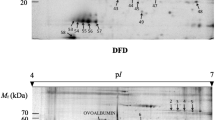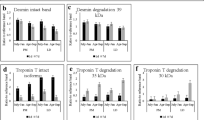Abstract
It is well known that preslaughter (antemortem) stress such as rough handling, transportation, a negative environment, physical discomfort, lack of consistent routine, and bad feed quality has a big impact on meat quality. The antemortem-induced poor meat quality is characterized by low pH, a pale and exudative appearance, and a soft texture. Previous studies indicate that antemortem stress plays a key role in regulating protein acetylation and glycolysis in postmortem (PM) muscle. However, the underlying molecular and biochemical mechanism is not clearly understood yet. In this study, we investigated the relationship between antemortem and protein acetylation and glycolysis using murine longissimus dorsi muscle isolated from ICR mice and murine muscle cell line C2C12 treated with epinephrine hydrochloride. Because adrenaline secretion increases in stressed animals, epinephrine hydrochloride was intraperitoneally injected epinephrine into mice to simulate pre-slaughter stress in this study to facilitate experimental operations and save experimental costs. Our findings demonstrated that protein acetylation in pyruvate kinase M1 (PKM1) form is significantly reduced by antemortem, and the reduced acetylation subsequently leads to an increase in PKM1 enzymatic activity which causes increased glycolysis in PM muscle. By using molecular approaches, we identified lysine 141 in PKM1 as a critical residue for acetylation. Our results in this study provide useful insight for controlling or improving meat quality in the future.










Similar content being viewed by others
References
Guardia MD, Estany J, Balasch S, Oliver MA, Gispert M, Diestre A (2004) Risk assessment of PSE condition due to pre-slaughter conditions and RYR1 gene in pigs. Meat Sci 67(3):471–478. https://doi.org/10.1016/j.meatsci.2003.11.020
Leheska JM, Wulf DM, Maddock RJ (2002) Effects of fasting and transportation on pork quality development and extent of postmortem metabolism. J Anim Sci 80(12):3194–3202. https://doi.org/10.2527/2002.80123194x
Rosenvold K, Andersen HJ (2003) Factors of significance for pork quality—a review. Meat Sci 64(3):219–237. https://doi.org/10.1016/S0309-1740(02)00186-9
Briskey EJ (1964) Etiological status and associated studies of pale, soft, exudative porcine musculature. Adv Food Res 13:89–178. https://doi.org/10.1016/s0065-2628(08)60100-7
Solomon MB, Van Laack LM, Eastridge JS (1998) Biophysical basis of pale, soft, exudative (PSE) pork and poultry muscle: a review. J Muscle Foods 9:1–12
Shen QW, Means WJ, Thompson SA, Underwood KR, Zhu MJ, McCormick RJ, Ford SP, Du M (2006) Pre-slaughter transport, AMP-activated protein kinase, glycolysis, and quality of pork loin. Meat Sci 74(2):388–395. https://doi.org/10.1016/j.meatsci.2006.04.007
Shen QW, Means WJ, Underwood KR, Thompson SA, Zhu MJ, McCormick RJ, Ford SP, Ellis M, Du M (2006) Early post-mortem AMP-activated protein kinase (AMPK) activation leads to phosphofructokinase-2 and -1 (PFK-2 and PFK-1) phosphorylation and the development of pale, soft, and exudative (PSE) conditions in porcine longissimus muscle. J Agric Food Chem 54(15):5583–5589. https://doi.org/10.1021/jf060411k. (PMID: 16848549)
Kouzarides T (2000) Acetylation: a regulatory modification to rival phosphorylation? EMBO J 19(6):1176–1179. https://doi.org/10.1093/emboj/19.6.1176
Phillips DM (1963) The presence of acetyl groups of histones. Biochem J 87:258–263
Ali I, Conrad RJ, Verdin E, Ott M (2018) Lysine acetylation goes global: from epigenetics to metabolism and therapeutics. Chem Rev 118(3):1216–1252. https://doi.org/10.1021/acs.chemrev.7b00181
Montgomery DC, Sorum AW, Meier JL (2015) Defining the orphan functions of lysine acetyltransferases. ACS Chem Biol 10(1):85–94. https://doi.org/10.1021/cb500853p
Spange S, Wagner T, Heinzel T, Kramer OH (2009) Acetylation of non-histone proteins modulates cellular signalling at multiple levels. Int J Biochem Cell Biol 41(1):185–198. https://doi.org/10.1016/j.biocel.2008.08.027
Jiang S, Liu Y, Shen Z, Zhou B, Shen QW (2019) Acetylome profiling reveals extensive involvement of lysine acetylation in the conversion of muscle to meat. J Proteomics 205:103412. https://doi.org/10.1016/j.jprot.2019.103412
Wang Q, Zhang Y, Yang C, Xiong H, Lin Y, Yao J, Li H, Xie L, Zhao W, Yao Y, Ning ZB, Zeng R, Xiong Y, Guan KL, Zhao S, Zhao GP (2010) Acetylation of metabolic enzymes coordinates carbon source utilization and metabolic flux. Science 327(5968):1004–1007. https://doi.org/10.1126/science.1179687
Zhao S, Xu W, Jiang W, Yu W, Lin Y, Zhang T, Yao J, Zhou L, Zeng Y, Li H, Li Y, Shi J, An W, Hancock SM, He F, Qin L, Chin J, Yang P, Chen X, Lei Q, Xiong Y, Guan KL (2010) Regulation of cellular metabolism by protein lysine acetylation. Science 327(5968):1000–1004. https://doi.org/10.1126/science.1179689
Li Z, Li X, Wang Z, Shen QW, Zhang D (2016) Antemortem stress regulates protein acetylation and glycolysis in postmortem muscle. Food Chem 202:94–98. https://doi.org/10.1016/j.foodchem.2016.01.085
Zhou B, Shen Z, Liu Y, Wang C, Shen QW (2019) Proteomic analysis reveals that lysine acetylation mediates the effect of antemortem stress on postmortem meat quality development. Food Chem 293:396–407. https://doi.org/10.1016/j.foodchem.2019.04.122
Kemp CM, Sensky PL, Bardsley RG, Buttery PJ, Parr T (2010) Tenderness—an enzymatic view. Meat Sci 84(2):248–256. https://doi.org/10.1016/j.meatsci.2009.06.008. (Epub 2009 Jun 8; PMID: 20374783)
Scheffler TL, Gerrard DE (2007) Mechanisms controlling pork quality development: the biochemistry controlling postmortem energy metabolism. Meat Sci 77(1):7–16. https://doi.org/10.1016/j.meatsci.2007.04.024. (Epub 2007 May 10 PMID: 22061391)
Wulf DM, Emnett RS, Leheska JM, Moeller SJ (2002) Relationships among glycolytic potential, dark cutting (dark, firm, and dry) beef, and cooked beef palatability. J Anim Sci 80(7):1895–1903. https://doi.org/10.2527/2002.8071895x. (PMID: 12162657)
Li Q, Li Z, Lou A, Wang Z, Zhang D, Shen QW (2017) Histone acetyltransferase inhibitors antagonize AMP-activated protein kinase in postmortem glycolysis. Asian Australas J Anim Sci 30(6):857–864. https://doi.org/10.5713/ajas.16.0556
Muirhead H, Clayden DA, Barford D, Lorimer CG, Fothergill-Gilmore LA, Schiltz E, Schmitt W (1986) The structure of cat muscle pyruvate kinase. EMBO J 5(3):475–481. https://doi.org/10.1002/j.1460-2075.1986.tb04236.x
Filipp FV (2013) Cancer metabolism meets systems biology: pyruvate kinase isoform PKM2 is a metabolic master regulator. J Carcinog 24(12):14. https://doi.org/10.4103/1477-3163.115423. (PMID: 23961261; PMCID: PMC3746496)
Liu M, Wang Y, Ruan Y, Bai C, Qiu L, Cui Y, Ying G, Li B (2018) PKM2 promotes reductive glutamine metabolism. Cancer Biol Med 15(4):389–399. https://doi.org/10.20892/j.issn.2095-3941.2018.0122. (PMID: 30891326; PMCID: PMC6420233)
Li Q, Li C, Elnwasany A, Sharma G, An YA, Zhang G, Elhelaly WM, Lin J, Gong Y, Chen G, Wang M, Zhao S, Dai C, Smart CD, Liu J, Luo X, Deng Y, Tan L, Lv SJ, Davidson SM, Locasale JW, Lorenzi PL, Malloy CR, Gillette TG, Vander Heiden MG, Scherer PE, Szweda LI, Fu G, Wang ZV (2021) PKM1 exerts critical roles in cardiac remodeling under pressure overload in the heart. Circulation 144(9):712–727. https://doi.org/10.1161/CIRCULATIONAHA.121.054885. (Epub 2021 Jun 9. PMID: 34102853; PMCID: PMC8405569)
Lv L, Li D, Zhao D, Lin R, Chu Y, Zhang H, Zha Z, Liu Y, Li Z, Xu Y, Wang G, Huang Y, Xiong Y, Guan KL, Lei QY (2011) Acetylation targets the M2 isoform of pyruvate kinase for degradation through chaperone-mediated autophagy and promotes tumor growth. Mol Cell 42(6):719–730. https://doi.org/10.1016/j.molcel.2011.04.025
Park SH, Ozden O, Liu G, Song HY, Zhu Y, Yan Y, Zou X, Kang HJ, Jiang H, Principe DR, Cha YI, Roh M, Vassilopoulos A, Gius D (2016) SIRT2-mediated deacetylation and tetramerization of pyruvate kinase directs glycolysis and tumor growth. Cancer Res 76(13):3802–3812. https://doi.org/10.1158/0008-5472.CAN-15-2498
Jiang S, Shen Q (2020) Construction of lentiviral overexpression vector of mouse PKM1 gene and screening of stably transfected C2C12 cell line and its effect of PKM1 on glycolysis. Sci Technol Food Ind 41(10):8
Lv L, Xu YP, Zhao D, Li FL, Wang W, Sasaki N, Jiang Y, Zhou X, Li TT, Guan KL, Lei QY, Xiong Y (2013) Mitogenic and oncogenic stimulation of K433 acetylation promotes PKM2 protein kinase activity and nuclear localization. Mol Cell 52(3):340–352. https://doi.org/10.1016/j.molcel.2013.09.004
Reem NT, Van Eck J (2019) Application of CRISPR/Cas9-mediated gene editing in tomato. Methods Mol Biol (Clifton, NJ) 1917:171–182. https://doi.org/10.1007/978-1-4939-8991-1_13
Park J, Chen Y, Tishkoff DX, Peng C, Tan M, Dai L, Xie Z, Zhang Y, Zwaans BM, Skinner ME, Lombard DB, Zhao Y (2013) SIRT5-mediated lysine desuccinylation impacts diverse metabolic pathways. Mol Cell 50(6):919–930. https://doi.org/10.1016/j.molcel.2013.06.001
Jiang W, Wang S, Xiao M, Lin Y, Zhou L, Lei Q, Xiong Y, Guan KL, Zhao S (2011) Acetylation regulates gluconeogenesis by promoting PEPCK1 degradation via recruiting the UBR5 ubiquitin ligase. Mol Cell 43(1):33–44. https://doi.org/10.1016/j.molcel.2011.04.028. (PMID: 21726808; PMCID: PMC3962309)
Funding
This study was supported by the National Natural Science Foundation of China (Grant Number: 31571862; 5026301).
Author information
Authors and Affiliations
Contributions
Conceptualization, QWS and SJ; methodology, SJ; formal analysis, QWS, investigation, QWS; writing-original draft preparation, SJ; writing-review and editing, QWS; project administration, QWS; funding acquisition, QWS. All authors have read and agreed to the published version of the manuscript.
Corresponding author
Ethics declarations
Conflict of interest
The authors declare no conflict of interest. The funders had no role in the design of the study; in the collection, analyses, or interpretation of data, in the writing of the manuscript, or in the decision to publish the results.
Informed Consent
Informed consent was obtained from all subjects involved in the study.
Additional information
Publisher's Note
Springer Nature remains neutral with regard to jurisdictional claims in published maps and institutional affiliations.
Supplementary Information
Below is the link to the electronic supplementary material.
Rights and permissions
Springer Nature or its licensor (e.g. a society or other partner) holds exclusive rights to this article under a publishing agreement with the author(s) or other rightsholder(s); author self-archiving of the accepted manuscript version of this article is solely governed by the terms of such publishing agreement and applicable law.
About this article
Cite this article
Jiang, S., Shen, Q.W. Antemortem Stress Regulates Postmortem Glycolysis in Muscle by Deacetylation of Pyruvate Kinase M1 at K141. Protein J 43, 351–361 (2024). https://doi.org/10.1007/s10930-023-10178-6
Accepted:
Published:
Issue Date:
DOI: https://doi.org/10.1007/s10930-023-10178-6




